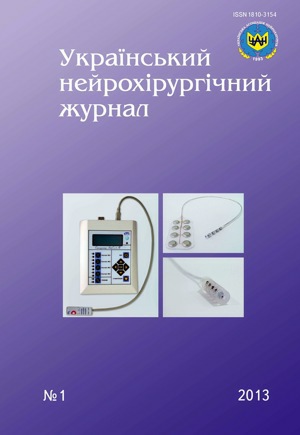CT-cisternography in the diagnosis and treatment of non-traumatic cerebrospinal fluid rhinorrhoea: Clinical series and literature review
DOI:
https://doi.org/10.25305/unj.55536Keywords:
non-traumatic CSF rhinorrhoea, diagnostics, CT-cisternography, treatmentAbstract
Introduction. Cerebrospinal fluid (CSF) rhinorrhoea— is leakage of CSF into nasal cavity due to defects in the bones of the skull base and dura mater of different etiology. CSF rhinorrhoea is divided into two major types — non-traumatic and traumatic.
Methods. To evaluate the efficacy of CT-cysternography in diagnosis of non-traumatic CSF rhinorrhoea 143 patients were examined. All patients underwent intrathecal introduction of nonionic contrast agents followed by CT-scanning.
Results. According to CT-cysternography data, we obtained evacuation of contrasted CSF from subarachnoid space in all of patients. The “CSF trace” allowed us to identify the precise positioning of CSF fistula and to precisely determine “target” for surgery. In 122 (85.3%) patients the defect of the skull base was present in the area of anterior cranial fossa — in ethmoid bone, in 21 (4.7%) — in the area of sphenoid sinus. In all cases the diagnosis was confirmed during the surgery.
Conclusions. Non-traumatic CSF rhinorrhoea most frequently occurs in middle-aged women with accompanying obesity and hypertension. CT-cysternography allowed us to determine the source of non-traumatic CSF rhinorrhoea in all cases. Precise identification of dimensions of CSF fistula and its localization allowed us to apply with high grade of efficacy transnasal approach in non-traumatic CSF rhinorrhoea surgery.
References
1. Benedict M, Schultz-Coulon HJ. [Spontaneous cerebrospinal rhinorrhea. Etiology--differential diagnosis--therapy]. HNO. 1991;39(1):1-7. German. [PubMed]
2. Woodworth B, Prince A, Chiu A et al. Spontaneous CSF leaks: A paradigm for definitive repair and management of intracranial hypertension. Otolaryngology - Head and Neck Surgery. 2008;138(6):715-720. [CrossRef] [PubMed]
3. Wax MK, Ramadan HH, Ortiz O, Wetmore SJ. Contemporary management of cerebrospinal fluid rhinorrhea. Otolaryngol Head Neck Surg. 1997;116(4):442-449. [PubMed]
4. Kapitanov DN. Vnutrinosovyye endoskopicheskiye metodiki v diagnostike i lechenii patologii osnovaniya cherepa. [dissertation]. Moscow (Russia); 2004. Russian.
5. Ricchetti A, Burkhard P, Rodrigo N et al. Skull base cerebrospinal fluid fistula: a novel detection method based on two-dimensional electrophoresis. Head Neck. 2004;26(5):464-469. [CrossRef] [PubMed]
6. Shugar JM, Som PM, Eisman W, Biller HF. Non-traumatic cerebrospinal fluid rhinorrhea. The Laryngoscope. 1981;91(1):114-120. [CrossRef] [PubMed]
7. Silver R, Moonis G, Schlosser R, Bolger W, Loevner L. Radiographic signs of elevated intracranial pressure in idiopathic cerebrospinal fluid leaks: A possible presentation of idiopathic intracranial hypertension. American Journal of Rhinology. 2007;21(3):257-261. [CrossRef]
8. Zorin NA, Mosiychuk NM, Sirko AG, Salkov NN: Plasticheskoye zakrytiye bazalnykh defektov cherepa pri spontannoy likvoreye. In: Abstract Book of Conf.; 2010, October 7-8; Partenit, Crimea. Partenit, 2010. Russian.
9. Salkov MM. Diahnostyka ta khirurhichne likuvannya travmatychnoyi nazalnoyi likvoreyi [Diagnostic and surgical treatment of the nontraumatic cerebrospinal fluid rhinorrhea]. [dissertation]. Kiev (Ukrainian); 2005. Ukrainian.
10. Shetty PG, Shroff MM, Fatterpekar GM, Sahani DV, Kirtane MV. A retrospective analysis of spontaneous sphenoid sinus fistula: MR and CT findings. AJNR Am J Neuroradiol. 2000;21(2):337-342. [PubMed]
11. Schuller DE, Goodman JH, Miller CA. Reconstruction of the skull base. The Laryngoscope. 1984;94(10):1359-1364. [CrossRef] [PubMed]
12. Osipova VA. K anatomii peredney cherepnoy yamki. Aktualnyye voprosy teoreticheskoy i prakticheskoy meditsiny. 1971;71:131–133. Russian.
13. Ramsden J, Corbridge R, Bates G. Bilateral cerebrospinal fluid rhinorrhoea. The Journal of Laryngology & Otology. 2000;114(2):137-138. [CrossRef] [PubMed]
14. Hegazy H, Carrau R, Snyderman C, Kassam A, Zweig J. Transnasal Endoscopic Repair of Cerebrospinal Fluid Rhinorrhea: A Meta-Analysis. The Laryngoscope. 2000;110(7):1166-1172. [CrossRef] [PubMed]
15. Locke C. The Spontaneous escape of cerebrospinal fluid through the nose. Arch NeurPsych. 1926;15(3):309. [CrossRef]
16. Johanson CE, Donahue JE, Spangenberger A, Stopa EG, Duncan JA, Sharma HS. Atrial natriuretic peptide: its putative role in modulating the choroid plexus-CSF system for intracranial pressure regulation. Acta Neurochir Suppl. 2006;96:451-456. [PubMed]
17. Grisoli F, Vincentelli F, Henry J, Thomassin J. Anatomical bases for the transphenoidal approach to the pituitary gland. Anatomia Clinica. 1982;3(3):207-220. [CrossRef]
18. Makhmurian MS, Kravchuk AD, Kapitanov DN, Potapov AA, Likhterman LB. [Predisposing factors, etiology and pathogenesis of spontaneous nasal CSF leak]. Zh Vopr Neirokhir Im N N Burdenko. 2011;75(2):77-84. Russian. [PubMed]
19. Yamaguchi T. The calcium-sensing receptor in bone. J Bone Miner Metab. 2008;26(4):301-311. [CrossRef] [PubMed]
20. Schlosser RJ, Wilensky EM, Grady MS, Bolger WE. Elevated intracranial pressures in spontaneous cerebrospinal fluid leaks. Am J Rhinol. 2003 Jul-Aug;17(4):191-195. [PubMed]
Downloads
Published
How to Cite
Issue
Section
License
Copyright (c) 2013 Andriy Sirko, Andrey Dyadechko

This work is licensed under a Creative Commons Attribution 4.0 International License.
Ukrainian Neurosurgical Journal abides by the CREATIVE COMMONS copyright rights and permissions for open access journals.
Authors, who are published in this Journal, agree to the following conditions:
1. The authors reserve the right to authorship of the work and pass the first publication right of this work to the Journal under the terms of Creative Commons Attribution License, which allows others to freely distribute the published research with the obligatory reference to the authors of the original work and the first publication of the work in this Journal.
2. The authors have the right to conclude separate supplement agreements that relate to non-exclusive work distribution in the form of which it has been published by the Journal (for example, to upload the work to the online storage of the Journal or publish it as part of a monograph), provided that the reference to the first publication of the work in this Journal is included.









